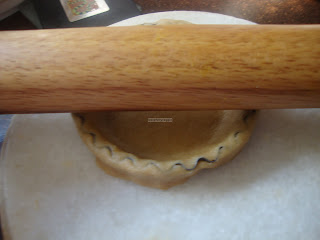Vanilla Tart (Low Fat Eggless)
Making western dishes has not been my strength mainly because I barely get opportunity to do so. My husband prefers Indian dishes, particularly south Indian and also the fact that there are ever so many Indian dishes I am yet to try gives me limited incentive to explore alternate cuisines. I do think that in order to be a good cook, one needs to try a variety of dishes and also was hoping that I could lure my wee one into trying some western dishes every now and then. I had bought fromage frais which is a curd cheese as well but much lesser in fat and cholesterol than cream cheese. I chose to use this instead of a full fat cheese filling. This tart is a kind of hybrid between a cheesecake and traditional tarts. The mixture of whole wheat flour and all purpose flour helps keep it healthy and delicious at the same time. I also used olive oil instead of butter to make the pastry so saturated fat is reduced. It is not too sweet so if you do have a sweet tooth you may want to add bit more sugar to the filling.
For the pastry:
½ cup all purpose flour
¾ cup whole wheat flour
50-60ml (1/4 cup) olive oilPinch of salt
2-3 tablespoons sugar
Cold water
For the filling:
500g fromage frais
1 teaspoon corn flour
3 tablespoon sugar
1 teaspoon vanilla extract
Slices of fruits of your choice for garnishTo make the pastry:
Add the flour, sugar and salt in a bowl and add the olive oil. Mix so it looks like breadcrumbs and add water and make a soft dough that is well combined
Put the fromage frais in a muslin cloth or a white cloth, roll it and squeeze excess water out. Alternately, let the fromage frais on the muslin cloth sit on a collander with a bowl placed underneath so the water drains. It may take about 2 hours or so but I prefer to squeeze it out as it prevents the cheese from becoming sour sitting outside. Some people put it in the fridge to avoid sour cheese




















































